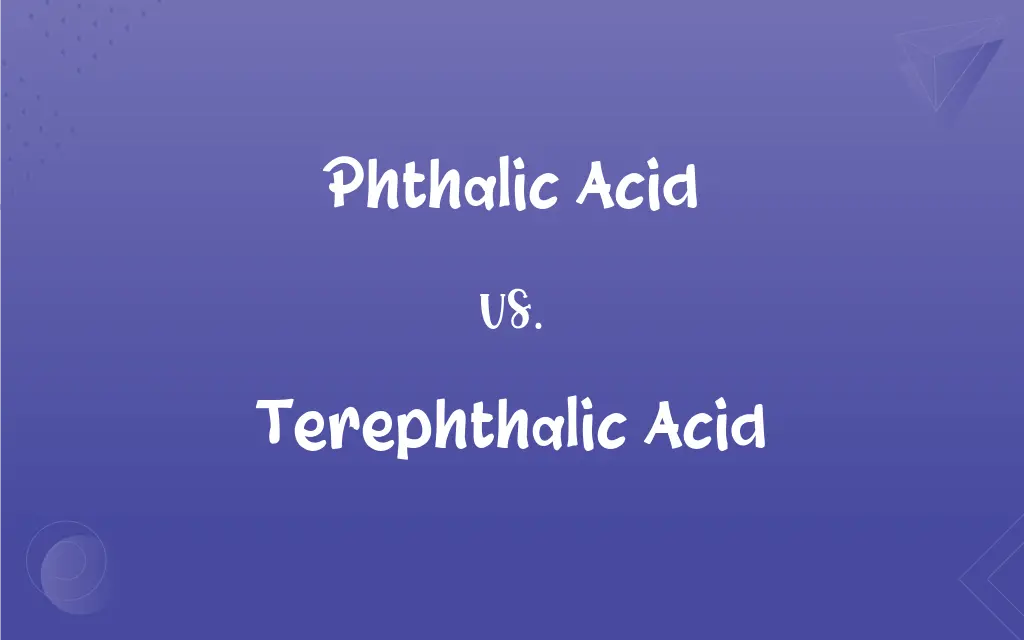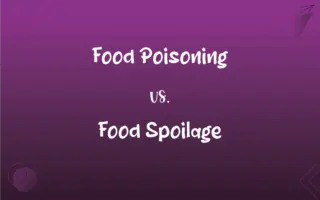Phthalic Acid vs. Terephthalic Acid: What's the Difference?
Edited by Aimie Carlson || By Harlon Moss || Published on January 5, 2024
Phthalic acid is an aromatic dicarboxylic acid with carboxyl groups on adjacent carbons, while terephthalic acid has its carboxyl groups on opposite ends of the benzene ring.

Key Differences
Phthalic acid, also known as benzene-1,2-dicarboxylic acid, has two carboxyl groups attached to adjacent carbon atoms on a benzene ring. Terephthalic acid, or benzene-1,4-dicarboxylic acid, has the carboxyl groups attached to carbon atoms opposite each other on the benzene ring.
The structure of phthalic acid makes it a key monomer in the production of phthalate plasticizers. In contrast, terephthalic acid is widely used in the manufacture of polyethylene terephthalate (PET), a common plastic.
Phthalic acid is less stable and more reactive due to the proximity of its carboxyl groups. Terephthalic acid, with its carboxyl groups further apart, is more stable and less reactive under normal conditions.
The use of phthalic acid is prominent in the production of dyes, resins, and plasticizers. Terephthalic acid, however, is crucial in creating strong and durable polymers for fibers and containers.
Environmental and health concerns regarding phthalates have led to scrutiny of phthalic acid use. Terephthalic acid, due to its different structure and use, is often considered safer in consumer products.
ADVERTISEMENT
Comparison Chart
Structural Formula
Benzene-1,2-dicarboxylic acid
Benzene-1,4-dicarboxylic acid
Carboxyl Group Position
Adjacent carbon atoms on benzene ring
Opposite carbon atoms on benzene ring
Primary Use
Phthalate plasticizers, dyes, resins
Production of PET and fibers
Stability and Reactivity
Less stable, more reactive
More stable, less reactive
Environmental Impact
Concerns due to phthalates
Considered safer for consumer products
ADVERTISEMENT
Phthalic Acid and Terephthalic Acid Definitions
Phthalic Acid
Aromatic dicarboxylic acid with adjacent carboxyl groups.
Phthalic acid is used in the synthesis of certain dyes.
Terephthalic Acid
Aromatic dicarboxylic acid with carboxyl groups on opposite ends.
Terephthalic acid is essential in making polyester fibers.
Phthalic Acid
Monomer in various industrial applications.
Phthalic acid plays a crucial role in the production of alkyd resins.
Terephthalic Acid
Integral in polyester and plastic industries.
Terephthalic acid contributes to the strength of polyester fabrics.
Phthalic Acid
Used in producing resins and plasticizers.
Phthalic acid derivatives are found in numerous consumer products.
Terephthalic Acid
More stable due to the positioning of carboxyl groups.
Terephthalic acid's stability makes it suitable for durable materials.
Phthalic Acid
Benzene-1,2-dicarboxylic acid.
Phthalic acid is a precursor for many plasticizers.
Terephthalic Acid
Used in the manufacture of strong polymers.
Terephthalic acid is crucial in creating beverage containers.
Phthalic Acid
Less stable due to the proximity of carboxyl groups.
Phthalic acid is reactive, making it useful in chemical industries.
Terephthalic Acid
Benzene-1,4-dicarboxylic acid.
Terephthalic acid is a key ingredient in PET plastic production.
FAQs
How are phthalic acid and terephthalic acid used?
Phthalic acid is used in plasticizers and resins, while terephthalic acid is used in making PET and fibers.
What is terephthalic acid?
Terephthalic acid is an aromatic dicarboxylic acid with carboxyl groups on opposite carbons of the benzene ring.
Why is phthalic acid reactive?
The proximity of its carboxyl groups makes phthalic acid more reactive.
Is terephthalic acid used in beverage containers?
Yes, it's used in manufacturing PET, commonly used in beverage containers.
What are the environmental concerns with phthalic acid?
Phthalates, derived from phthalic acid, raise environmental and health concerns.
Are phthalic acid and terephthalic acid structurally similar?
They both have a benzene ring and two carboxyl groups, but their positions differ.
What is phthalic acid?
Phthalic acid is an aromatic dicarboxylic acid with carboxyl groups on adjacent carbons.
How does the structure of terephthalic acid benefit its applications?
Its structure contributes to the durability and stability of polymers like PET.
What makes terephthalic acid stable?
The positioning of its carboxyl groups on opposite ends of the benzene ring enhances stability.
What are the safety considerations when handling phthalic acid?
Appropriate safety measures include avoiding inhalation and skin contact.
Can phthalic acid be used in dye manufacturing?
Yes, it's a key monomer in the production of certain dyes.
Are phthalic acid derivatives widespread in consumer products?
Yes, they are found in a wide range of products, from plastics to personal care items.
How does phthalic acid affect plastic properties?
Phthalic acid derivatives often make plastics more flexible and durable.
What industrial processes use terephthalic acid?
It's used in the chemical industry for producing polymers and fibers.
Is terephthalic acid safer for consumer products?
Due to its structure and use, terephthalic acid is often considered safer.
Does terephthalic acid contribute to polyester strength?
Yes, it's integral to the strength and durability of polyester fabrics.
Is terephthalic acid found in everyday materials?
Yes, it's commonly found in polyester clothing and plastic bottles.
What type of polymers use phthalic acid?
Alkyd resins and plasticizers often use derivatives of phthalic acid.
Can phthalic acid be used in the production of alkyd resins?
Yes, it's a crucial component in alkyd resin synthesis.
Are terephthalic acid-based plastics recyclable?
Yes, PET plastics made from terephthalic acid are widely recyclable.
About Author
Written by
Harlon MossHarlon is a seasoned quality moderator and accomplished content writer for Difference Wiki. An alumnus of the prestigious University of California, he earned his degree in Computer Science. Leveraging his academic background, Harlon brings a meticulous and informed perspective to his work, ensuring content accuracy and excellence.
Edited by
Aimie CarlsonAimie Carlson, holding a master's degree in English literature, is a fervent English language enthusiast. She lends her writing talents to Difference Wiki, a prominent website that specializes in comparisons, offering readers insightful analyses that both captivate and inform.






































































